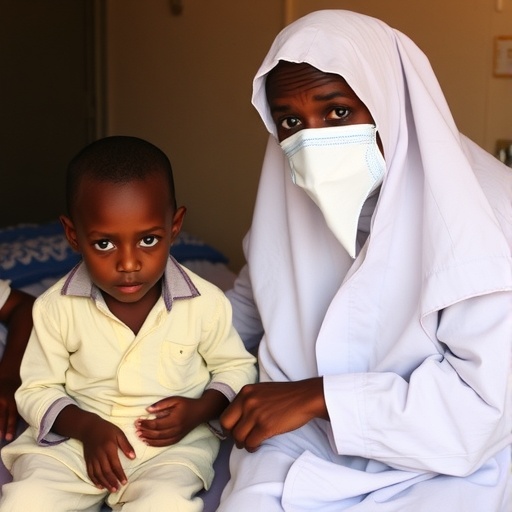
In a groundbreaking study published in Nature Communications, researchers have unveiled alarming new evidence regarding the acquisition of highly drug-resistant Escherichia coli strains by hospitalized children suffering from severe acute malnutrition (SAM) in Niger. This research highlights a critical and previously underappreciated public health threat: the convergence of malnutrition and antimicrobial resistance (AMR), which poses grave challenges for clinical treatment and infection control in low-resource healthcare settings.
The study focuses on E. coli strains that harbor extended-spectrum β-lactamase (ESBL) and carbapenemase genes—two formidable mechanisms that render bacteria resistant to some of the most potent classes of antibiotics currently available. ESBL-producing bacteria are resistant to a wide range of beta-lactam antibiotics including penicillins and cephalosporins, while carbapenemase-producing bacteria can deactivate carbapenems, which are often considered the last resort for severe bacterial infections. The presence of these resistance genes in bacterial populations complicates treatment regimens, often leaving physicians with limited therapeutic options and leading to poor clinical outcomes.
The research team conducted an extensive cohort study involving children admitted to hospitals in Niger with SAM, a condition characterized by severe wasting and nutritional deficiency. SAM is a major contributor to child mortality in sub-Saharan Africa, and the compromised immune systems of these children are especially vulnerable to infections. The scientists performed microbiological screenings to detect E. coli strains and assessed their genetic profiles for resistance markers. Their findings revealed widespread carriage and transmission of E. coli harboring ESBL and carbapenemase genes among these hospitalized children.
.adsslot_BXY0UTOnhI{width:728px !important;height:90px !important;}
@media(max-width:1199px){ .adsslot_BXY0UTOnhI{width:468px !important;height:60px !important;}
}
@media(max-width:767px){ .adsslot_BXY0UTOnhI{width:320px !important;height:50px !important;}
}
ADVERTISEMENT
This alarming revelation suggests that hospitalization itself may be a critical environment for the acquisition and dissemination of multi-drug resistant bacteria. The crowded wards, limited infection control measures, and frequent antibiotic use in this context seem to create a perfect storm for selecting and spreading these dangerous pathogens. The study therefore not only calls attention to the bacterial threat but also underscores systemic healthcare challenges contributing to AMR propagation in vulnerable populations.
Further genetic analyses showed that the resistance genes were often located on mobile genetic elements such as plasmids, which facilitate rapid horizontal gene transfer between bacterial species. This mode of gene transfer sharply increases the adaptability of bacterial populations and accelerates the spread of resistance traits, particularly in settings where antibiotic pressure is high. Understanding this mechanism is pivotal for designing targeted interventions to break the chains of transmission within healthcare environments.
The children in the study not only arrived at the hospital already carrying resistant E. coli, but many also acquired new resistant strains during their hospital stay. This finding accentuates the dual risk faced by these patients: the intersection of their malnourished state coupled with exposure to multidrug-resistant organisms during medical care. Effective management thus requires a multifaceted approach, involving improved nutritional support, antimicrobial stewardship, enhanced infection prevention practices, and robust surveillance.
Importantly, this research adds critical insight into the epidemiology of antimicrobial resistance in sub-Saharan Africa. While AMR is a global crisis, resource-constrained regions like Niger bear disproportionate burdens, magnified by high rates of infectious diseases, inadequate sanitation, and insufficient healthcare infrastructure. Data from this study provide the much-needed empirical evidence to advocate for international investment in AMR control measures tailored to these vulnerable contexts.
From a therapeutic standpoint, the presence of carbapenemase-producing E. coli in malnourished children necessitates urgent reassessment of empirical antibiotic guidelines. Carbapenems are often reserved as last-resort antibiotics, but their efficacy is rapidly waning in such settings. The study thus raises questions about the practicality of available treatments and the dire need for novel antimicrobials or adjunctive therapies to treat infections caused by these resistant strains.
The research also underscores the pivotal role of microbiological diagnostics in clinical management. Rapid, sensitive testing for ESBL and carbapenemase production can guide optimal antibiotic use, limiting unnecessary exposure and curbing selection for resistance. However, implementing such diagnostics in resource-limited hospitals remains a formidable challenge, necessitating innovative solutions including affordable point-of-care tests and enhanced laboratory capacity building.
Beyond the hospital walls, the findings hint at a broader ecological issue. Malnutrition-driven immune suppression may predispose children to prolonged carriage and shedding of resistant bacteria, fueling community spread. The study prompts an urgent call to extend surveillance and control strategies beyond healthcare settings, incorporating community health interventions and sanitation improvements to tackle the AMR reservoir holistically.
The societal and policy implications of this research are profound. Policymakers must recognize the intertwined nature of malnutrition and AMR as a syndemic—two synergistic epidemics that exacerbate each other’s impact. This recognition should drive integrated programmatic efforts that address nutrition, infection control, antimicrobial stewardship, and health system strengthening simultaneously.
Moreover, the study’s data could influence global health agendas by highlighting the unique vulnerability of malnourished pediatric populations to AMR pathogens. These insights should catalyze funding priorities aimed at developing context-specific preventive measures, including vaccination strategies and novel therapeutics, aligned with the realities of healthcare delivery in low-income countries.
In conclusion, the acquisition of ESBL and carbapenemase-producing E. coli among hospitalized children with SAM in Niger presents a daunting challenge at the intersection of infectious disease, nutrition, and antimicrobial resistance. This study illuminates the pressing need for comprehensive healthcare strategies that go beyond fighting single diseases to addressing the complex interplay of factors that threaten child survival. The urgency is clear: without swift action, the combined burden of malnutrition and drug-resistant infections risks undermining progress in global child health for years to come.
Subject of Research: Acquisition and carriage of multidrug-resistant Escherichia coli strains in hospitalized children with severe acute malnutrition in Niger.
Article Title: Acquisition of Escherichia coli carrying extended-spectrum ß-lactamase and carbapenemase genes by hospitalised children with severe acute malnutrition in Niger.
Article References:
Sands, K., Lankapalli, A.K., Lai, G. et al. Acquisition of Escherichia coli carrying extended-spectrum ß-lactamase and carbapenemase genes by hospitalised children with severe acute malnutrition in Niger. Nat Commun 16, 6751 (2025). https://doi.org/10.1038/s41467-025-61718-w
Image Credits: AI Generated
Tags: antibiotic resistance in pediatric patientsantimicrobial resistance in healthcarechild mortality in sub-Saharan Africaclinical treatment of drug-resistant infectionsconsequences of malnutrition on healthdrug-resistant E. coli in NigerESBL and carbapenemase geneshospitalized malnourished childreninfection control challenges in malnourished childrennutritional deficiency and immune systempublic health threats in low-resource settingssevere acute malnutrition and AMR





